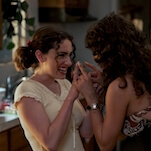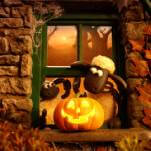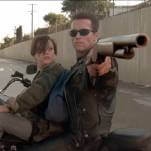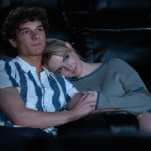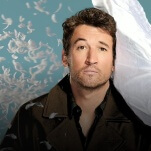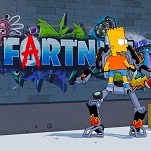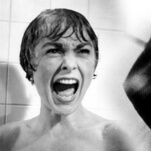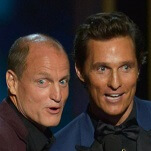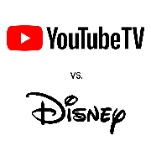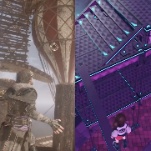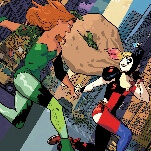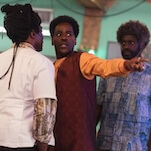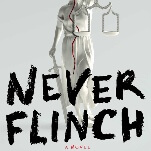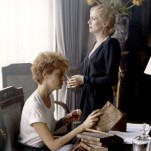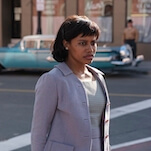Jules Feiffer
Jules Feiffer’s lines are wavy, but his aim is unerring. As a playwright, screenwriter, and, most famously, as the in-house cartoonist at The Village Voice from 1956 to 1997, Feiffer has turned a piercing, jaundiced eye on half a century of American culture.
After a brief stint apprenticing for the legendary Will Eisner on The Spirit (and eventually ghost-writing a number of strips), in 1951, Feiffer was drafted into the Army, where the radical leftism of his youth was honed into a lifelong antipathy for the hypocrisies of power. In the early years of his strip, first titled Sick, Sick, Sick and later simply Feiffer, he perfected a deceptively simple style: loose, sketchy drawings, floating in a sea of white space, with no background cover for the characters to hide behind.
Revealing themselves through inner monologues, Feiffer’s characters, famous and unknown alike, drop the social niceties and expose themselves at their ugliest. Although he hardly spares the powerful, some of Feiffer’s greatest wrath is directed at the wishy-washy white liberals of what he eventually called “the radical middle.” His scorched-earth take on the gender wars, carried through into his screenplay for 1971’s Carnal Knowledge, is no more forgiving.
Feiffer’s work has been fitfully anthologized over the years, but Explainers (Fantagraphics) is an unprecedented feast for the Feiffer fan. The first of a planned four volumes collecting all of Feiffer’s Voice strips, the handsome 546-page book covers 1956 to 1966. Feiffer, who is currently at work on a musical adaptation of his book The Man In The Ceiling, spoke from his summer home in Martha’s Vineyard about Jewish mothers, the Obama campaign, and working with Robert Altman on the 1980 movie Popeye.
The A.V. Club: It’s surprising, reading the book, how early the strip’s sensibility was formed. Almost right from the beginning, you deal with the themes that preoccupied you for the next 40 years.
Jules Feiffer: Originally, there were going to be a few weeks of introductory strips before I started serializing Munro. When I went to the Voice, I showed them Munro—and maybe Passionella, although I’m not sure I’d written Passionella by then—and something on the bomb called Boom!—what today would be called graphic novellas. They were just long narrative cartoons. They had political content to the extent that they were strongly anti-government, anti- the prevailing political tides of the time. I though what I’d do was break the longer stuff down into weekly installments, but I thought it might be difficult in the beginning for readers to figure out what I was doing and what the hell was going on, so perhaps I should do five or six or seven weeks of introductory strips to tell them who I was and what I was going to do. The introductory strips were still taking over 40 years later. Once I got into the habit and routine of it, I realized what a good format this was for me, and how much better it was than serializing work I’d already done which wasn’t designed for that format and would never be ideal for it.
AVC: The visual style, on the other hand, changes visibly from week to week. It isn’t until 1958 that we start to see that classic scribbly Feiffer line.
JF: It took a long time.
AVC: Did you have a sense of what you were trying to achieve in terms of the drawing?
JF: You’re asking the least qualified person, namely the one who does it. The artwork had very little to do with the thought process, and the writing too, for that matter. What happens, happens, and it happens outside the brain. Over the years, I discovered over and over again that once you lose control, you have a chance of getting good at it. And once you’re controlling the work, it’s not going to be very good, or it won’t be as good as it should be.
I seemed to have instinctually a strong idea of how the strip had to be written from the beginning. That changed too, but it was more in the direction of where it was headed. I didn’t have a clue as to the drawing style, because the drawing style that I was groomed on from the beginning was newspaper comic strips, which were much more conventional. The least conventional of all, and the most interesting, was Walt Kelly. I tried to ape a Walt Kelly kind of technique when I did the back page of Eisner’s Spirit, a strip called Clifford. But clearly that was in the newspaper comic-strip tradition, and I thought that what I was trying to do here was well outside that tradition, so I started looking elsewhere for people to steal from. I came across George Grosz, and André François, who was a French- Romanian cartoonist, and the rather radical non-New Yorker work of both Saul Steinberg and William Steig. And also UPA, which was doing very experimental animated cartoons at the time: Gerald McBoing-Boing, the nearsighted Mr. Magoo, the Thurber one [The Unicorn In The Garden]. They did just wonderful stuff.
So I was floundering, but I was happily floundering. I felt no sense of crisis. I was in my playpen. Throwing around stuff, and happy as a clam. Each week, it seemed for a while, I was trying something else. Then one day I stumbled upon these wooden dowels and I put them in ink, and they gave me a line for the first time that I liked. What I was desperate for, and it lasted long after the wooden dowels, was to find a way of drawing that was as comfortable as drawing in pencil when I was a kid, and which had a sense of the same immediacy. Immediacy was what was interesting to me, and still is. In all my work, the writing as well, I try to make it look as if it just appeared seamlessly on the page. That it wasn’t even crafted. It just happened. That’s what I was looking for. Eventually, if it’s on your mind, you stumble on it. You need a certain amount of luck and persistence. I can’t say it was planned or designed. I just woke up one day and I could do it. But when I could really do it was some 20 years after this book comes out.
AVC: You mean 1980’s Tantrum? You’ve said that was a breakthrough for you.
JF: Tantrum taught me everything. First of all, it taught me not to do any preliminary drawing. Once I was on that track, and I gave myself the confidence of doing a finished [drawing] on good quality paper and not worrying about screwing up—and if I did screw up, I did it all over again—I started to fly.
AVC: You redrew Passionella from scratch, didn’t you?
JF: It was Pageant magazine that commissioned it back in the late ’50s, and made it a cover story. It got a lot of attention. People loved it and I hated it, because I couldn’t stand to look at it. I thought it was so ugly, so badly [drawn]. I couldn’t imagine how badly I had fucked up this golden opportunity, except no one but me seemed to notice. When it came time to do the book of Passionella [in 1959], I was certainly not going to let that stuff in print, so I redrew it all. By that time, I knew what I was doing, and it came out the way I wanted. If you take a look at the Passionella collection that Fantagraphics put out last year, it’s in there, and I’m very proud of it.
AVC: The format of the Feiffer strip gave you a lot of freedom. You don’t draw backgrounds, and the layouts are very fluid. You don’t use a grid, or even formal panels, just panel-like areas that can vary in size and shape in the course of a single strip. Was that a style that was around at the time?
JF: No. Eisner would occasionally fool with Spirit stories where he eliminated panels, and other cartoonists would within a regular strip have three in borders and one without one. All the early [Feiffer] strips have a kind of crude border, the first three or four. If you look at it, I was surprised to find this, that I started with borders, I do without borders, I go back to borders. I start with balloons, I leave out balloons, and then I go back to balloons. I had not much of a finished idea of what I was doing. I actually waited for the paper to come out that week to see what it looked like. I didn’t know when I did the original what it looked like. So I’d have to see it in print.
Interesting story, in regard to how different it is in print from what you had on your drawing board, is that I had done what may have been the first Jewish mother cartoon, which is in this book, and the first time I did it, I thought, “Oh my God, it
looks exactly like my mother. She will kill me.” So I had to take that drawing out. I did another one, and it came out in the paper, and it looked exactly like my mother. Now, it didn’t look like my mother on my drawing table. The phone rang as soon as the paper came out, and she called up, and I had to lie through my teeth and deny everything.
AVC: Mothers make a number of appearances in the Explainers strips, but fathers don’t tend to show up nearly as often. Why is that?
JF: Well, if you came from a Jewish family, you wouldn’t have asked this question.
AVC: Was the lack of panel borders a practical decision? Were you more comfortable not chaining yourself to a preset grid?
JF: It wasn’t a matter of comfort. It’s all about storytelling and staging. This is a dramatic form on paper. Long before I ever thought I’d write plays, I was staging these things so it would be most effective in making my point. I knew what I was saying in many of these strips was complicated and nuanced and unfamiliar to readers of comics, or for that matter, readers of anything in newspapers. So I wanted to bring the reader along in as unchallenging a way as possible, to basically hoodwink readers into looking at this very simple piece of work and thinking “This is gonna be easy stuff,” and grabbing them by the throat. It’s a pattern I’ve followed in theater and film, too. If there’s something that’s important for you to say, you find as entertaining and as unthreatening and as unpolemical and as un-self-righteous a way of saying it as you can.
AVC: People tend to think of you as a political cartoonist, but the political strips in the book tend to be more in the vein of cultural criticism than attacks on specific figures.
JF: I was never interested in the two-party system per se. I was interested in how
authority was abused by government, and how lies were told, and rewritten, to seem to be true. I came up out of a tradition of radical journalism. The people I read were I.F. Stone, Murray Kempton. They basically taught me how to think and perceive politically. And I follow it to this day.
AVC: In The Great Comic Book Heroes, you write that you couldn’t read Terry And The Pirates at home because your parents considered the Daily News an anti-Semitic paper. But you’ve also said that they were politically timid, that their “pogrom paranoia” made them afraid to rock the boat.
JF: They were terrified of the outsider status that had been consigned to them, and when that status had lightened and alleviated, they consigned it to themselves, so they never lost it. My older sister was a Communist. I wrote a play about her called A Bad Friend. When she and I would get into a political argument, my mother would go around closing windows. This is in a left-wing neighborhood. But the fear of doing something, saying something that might agitate someone—the New Yorker cover [of Barack Obama] is a perfect example of my mother’s sensibility. The people who go around explaining why the New Yorker cover is a bad idea and the harm it can do, you could quote my mother on it. It goes on all day, all across the board. People are afraid, as they were in the 1950s, in McCarthy and post-McCarthy days. I came along just as McCarthy ended. The habits people formed were habits I helped break, but they were still going on strongly at that time. And we’re back in them today.
AVC: It’s startling to read strips from 50 years ago and realize how relevant some of the political commentary still is.
JF: Rather than feeling flattered by that, I feel somewhat demoralized. When I went into this game, of course I went in to to be successful and famous and emulate my heroes in the business. But I also thought I might be part of some kind of movement that would affect things, and change the dynamic. For 15 minutes, that happened, and then it bounced back to arguably worse than it ever was.
That’s what’s interesting and exciting about the Obama campaign. Maybe it’s just another 15 minutes. People out there think, “Well, maybe something can be shifted.” But what I see, unfortunately, is that in the end it’s going to be all about race. The whole Muslim bullshit is all about race. Those people who say “I’m worried about him because of the Muslim thing” can’t say, “I’m worried about him because he’s a black man,” so the euphemism is “Muslim.” If he’s not ahead in the polls in late October by 15 points, he’s going to lose. If he’s up by 15 points, he might win by three.
AVC: Do you think October is when the serious mud will start to fly?
JF: I just think that the American antipathy [to having a black president] is only going to be offset by the atmosphere of crisis in the country, as it was in 1932. [Franklin] Roosevelt was an institutional character. There was nothing challenging about Roosevelt to the public sensibility. But with a black man, however attractive, and however clearly qualified, things really have to be lousy for us to give him a chance, even against a moron.
AVC:…and however much he moderates or dilutes his political positions.
JF: I sent this to The New York Times, I have no idea if they’re going to run it. Can I read you this text of a cartoon I just did? I’d done one for the Times about a year ago, when Obama was first running, and had a couple of people singing about him. And this is a similar couple. They’re going:
“Obama: Since you made the run, our lives are more fun, but there’s so much to be done
with Obama.
You’ll bring about change, you’ll narrow the range, left and right rearrange for
Obama.
Who clarifies? Who unifies? Who throws higher fives than Obama?
Whatever works to elect you doesn’t have to affect you;
When you’re president, go be Lincoln, but to get there, start rethinkin’.
We need you to win, we’ll understand if you sin, sell out to get in, Obama.
We’re counting on you, you’re what we are due, to make our dreams come true. If you lose, what will we do?
You must be Ourbama.”
I think that’s where the white electorate is at at the moment, who are for Obama.
AVC: In April, you did your first new Voice cartoon in 11 years, a fairly scathing attack on Hillary Clinton. How did that come about?
JF: Because the new editor, who’s a lovely guy, came to hear me give a talk at the Century Club, and came up afterward and said, “What does it take to get you back in the paper?” He’s the first one to come along in all these years to make that suggestion. And I said, ‘Pay me a lot of money, give me a full page, and I’m your guy. And let it be in color.’ So that’s what happened. They could not have been more cooperative. It was a little like The Front Page. I did this first as a rough, and brought it down there, and they wanted to run it right away. So they ran the rough, and to get it into the paper, I had to do some revision, because I needed the dates of some primaries, and I had got the dates wrong. So they set me up in the office at a desk, and I did some rewriting and fixed it up, and loved every second of it.
AVC: A lot has changed at the Voice since you left. Did the newsroom feel different?
JF: When I was there, the atmosphere seemed terrific. I went out for drinks afterward with the two editors, and we had a ball talking to each other. I was hoping more would come of it, and so far it hasn’t, but I hope that something will pop. The only thing that bothered me is what used to bother me at the Voice, which is that I’d hit these home runs, and I’d get virtually no feedback from the public. When I started running stuff for the Times, the change was amazing.
AVC: People don’t write letters as much anymore. If they can’t post a comment that shows up on the website within a few minutes, they lose interest.
JF: That’s a part of it. But when I had something in the Times, people would stop me in the street and say, “My God, where did you come up with that?”, and “That was incredible.” And that’s nice. You like that kind of validation at any age, at any time in your life. I was particularly proud of this Hillary cartoon, and I got very little of that.
AVC: You said once that a political cartoon is only effective if it draws blood. The Hillary cartoon certainly fulfills that mandate.
JF: Murray Kempton said years ago to me, “If you’re going to go after them, leave them for dead.”
AVC:
You said something along the lines of, “If they ask you for a copy, you’ve done something wrong.”
JF: It was the Johnson library who destroyed me by asking for the original of one of the most vicious anti-Johnson cartoons I think I’d done. And my response was, “All he has to do is get out of Vietnam. He can have my entire library.”
AVC: If only that had worked.
JF: Well, I didn’t think I was bargaining from a strong position.
AVC: Among other things, Explainers functions as a time capsule of public concerns. The strips from the late ’50s, for example, make frequent reference to psychoanalysis, which was becoming much more popular at the time. Were you in therapy then?
JF: I was in and out of psychotherapy, and I did go for a long period of time, three days a week, with three different therapists, two of whom I think were quite good, and one of whom had no qualifications at all. I think I was helped considerably. The stupidity of our own early insights about ourselves is rampant, and you need somebody on the outside to suggest you may not be the person you insist that you are. What still comes back to me, and it’s appalling in terms of my own ignorance, was it being suggested that I was very angry. And I was this charming, funny, lighthearted guy. I certainly wasn’t angry, and I couldn’t believe that this shrink could so misunderstand who and what I really was. It was only after a number of sessions, and waking up one morning and saying, “Oh shit, I’ve been caught…” But I didn’t know that. I didn’t know how enraged I was by so many things. I really didn’t.
AVC: So the strips must have really been coming out of your unconscious.
JF: Oh God, yes. Oh yes.
AVC: There are artists who say they won’t go to therapy because it might make them too well-adjusted to create.
JF: Tennessee Williams was one of those, I remember, and I said at the time, “The beauty part of the human creature, and particularly the artist, is, don’t worry about it. Once you solve problem A, problem B will start up. There are always going to be
plenty of problems to write about.”
AVC: One of the things that’s startling about the strips is how bleak they are. The pessimism is bracing, but also somewhat frightening.
JF: It may be as I was unaware of my anger, I was unaware of my pessimism. But I never thought I was a pessimist. I was just, as I saw it, trying to get at the truth, whether it was in terms of human behavior as in the Bernard [Mergendeiler] strips, or Carnal Knowledge, say, or in politics, where Eisenhower, or, for that matter Kennedy, would say one thing and do something else. There are cartoons in there which show my view of Kennedy during his administration as being one of incredible style and very little content. The New Frontier drag. I found him as appealing and as attractive and as sexy as everyone else did. But I thought that only a few weeks or months before he was assassinated did he take on a dimension that I began to admire, with the American University speech that he gave on the Cold War. I happened to meet Ted Sorensen for the first time at a cocktail party a couple of months ago, and I talked to him about that, and Sorensen said, “That was my proudest moment of the administration.”
AVC: One of the most moving strips in Explainers is your response to John F. Kennedy’s assassination, which ran the first week of 1964. You have a girl reading a storybook fable about Kennedy as a prince who awakened impassioned debate, and how the country was stunned into apathy by his death.
JF: “We won’t have to kill any more princes.” That’s certainly pessimistic. But after the assassination, not immediately, but certainly after Jack Ruby shot Lee Harvey Oswald, I felt that something had gone terribly wrong in the country, that we were entering a stage of national nervous breakdown, where all forms of authority were collapsing. That’s what made me a playwright. I wrote Little Murders strictly out of the sense of doom, because I didn’t think anybody else was writing or talking about this. I went into a long depression, in which I just felt gloomy, and I found that when therapy didn’t work, I could work my way out of it by figuring out what the fuck was going on. My illusion was, “I can give myself reasons that I can
believe, and circulate them. It will get better.” It never gets better, but that’s the illusion I maintained. Carnal Knowledge came out of that. Knock Knock came out of that. My marriage had just broken up, and I was trying to figure out some reason to go on with my life. So it’s about having no hope and inventing hope. Good enough.
AVC: For Art Garfunkel’s character, Carnal Knowledge is about the nightmare of marriage. For Jack Nicholson’s, it’s about the nightmare of staying single. There isn’t much hope there.
JF: The nightmare of marriage is with Candy Bergen. How bad can that be?
AVC: Well, clearly it’s Garfunkel’s problem that he can’t accept the happiness of marriage.
JF: That’s what I was trying to show in the piece, by the changing of age. That when they’re both in college, and they’re boy-men, it’s kind of charming and cute and funny. The character Jack plays is enraged when he can’t get from Bergen what she seems to give to Garfunkel. Nicholson was extraordinary. But it’s still boy stuff. Then, 10 years later, these guys are older, and they’re still talking the same way, and it takes on another shading. Then they’re in their 40s, and nothing has changed with them. And then it ain’t funny anymore. It’s a kind of adolescent narcissism that many men—and I’m sure you know them in your own life—persist in holding onto against all odds, including the fact that it doesn’t make them happy.
AVC: How do you rate Robert Altman’s movie of Popeye, made from your screenplay?
JF: I loved writing the script. I had great fun. One of the revelations was how terrific Robert Evans was throughout, and helpful and supportive. At one point, the star he had in mind, Dustin Hoffman, wanted to fire me and get another writer in. Instead, Evans, in a sense, fired Dustin. You don’t do that in Hollywood. First of all, they were good friends. The other thing is, you lose your financing. It wasn’t until a year or so later that Evans called and said, “Have you looked at Mork And Mindy?” I had, but it had never even occurred to me that Robin [Williams] could be Popeye, until Evans said that to me and I said, “Of course. Why didn’t I think of that?”
Altman was Altman. Altman and I had been friends, and we hung out some, and drank some, and I always knew that the first thing Altman did with a movie was trash the script. He wasn’t interested in telling a story or characters. He was kind of an abstract expressionist on screen. What he did was absolutely brilliant when it worked, but it wasn’t going to be my story. But he was the only one who was going to do it. So I feel lucky to have gotten maybe 40 or 50 percent of what I wrote onscreen, and the rest of it is what it is.
Oddly enough, I didn’t find this out until years later, the movie made a lot of money. It was a hit. Paramount hated Evans so much, and Altman too—it was [Michael] Eisner and [Barry] Diller at the time—they didn’t want anybody to know that the movie was a success. It was one of Paramount’s big grossers that year. It may be the only movie I wrote where I still get a royalty check every year. One of the things I never doubted was that Altman would get the right look, and it’s so right, and so are Robin and Shelley Duvall, and the parents. There’s so much in that that I do admire. I just wish that he had hunkered down and told my story.
AVC: 1989’s I Want To Go Home is a real oddity in your career. How did you get involved with Alain Resnais?
JF: Resnais was a sweetheart. This whole idea of me doing it was his. He loves cartoonists, as did Fellini. He asked me if I could come up with an idea, and I thought, “Well, this will never be shot, but at least we can always have Paris. I’ll move my entire family to Paris, and we’ll have this wonderful time if they make the movie.” I would make two or three trips to Paris to talk to him, he would come to New York to go over he script, and I liked very much what we came up with.
It was his idea to get Adolph Green. Adolph was a friend of mine, and I thought it was a wonderful idea. It was one of the sweetest moments of my career, to have dinner with Adolph and [his wife] Phyllis at Sardi’s, and talk in general about the script which I’d given him to read as a friend, and then tell him, “Resnais wants you for the part, and so do I.” He just turned white, and she screamed. I was so happy being the message deliverer. He was wonderful throughout, and Linda Lavin was wonderful. I thought that Depardieu, who didn’t speak English at the time and learned the whole thing by rote, was wonderful. But Resnais did a serious piece of miscasting with the daughter, who was awful, and that made a huge difference. And then he said he didn’t want me over there for the shooting. I would have helped, because so much of the American style, when it needed an American style, I could have nudged him on. He was afraid of me taking control, which is laughable. It could have been a lot different, a better movie, if I had been present.
AVC: In 1997, you ended your run at the Voice and started focusing on writing and illustrating children’s books, which is what you’ve mostly been doing since.
JF: It had nothing to do with giving up the strip. It had to do with giving up the
theater. I always need an obsession, something that occupies me on long-term things. The strip is a day’s work, or a day and a half at most. I need something that’s going to make me think of character and events and storyline and what happens here, and if she does this, then what does he do? This makes me very happy, to do this kind of work. What happened was, a good friend of mine wanted me to write his children’s book that he was going to illustrate, and then we had a difference of opinion, and I got so mad, I said, “Okay, fuck you, I’ll write my own children’s book, and it will be better than yours,” and that’s what I did.
The big change in my life was parenting. When I began doing these books, I had an
older child from my first marriage—she was out of the house—but also a 7-year-old. Or maybe she was 6 at the time of The Man In The Ceiling. I still remember her criticism of an illustration. She said, “Daddy, you’ve got two kids in the house, and they’re wearing sneakers. Girls go ’round the house barefoot.” So I had to go through all the illustrations and take the shoes off.
Without children, these books would never have existed. Having children, particularly having them later in life, it just changed my sensibility and my outlook and how I saw things, and essentially what I wanted to do with the work. Particularly those two books, The Man In The Ceiling and the one that followed, A Barrel Of Laughs, A Vale Of Tears, were just a joy. Then our adopted daughter Julie complained that I hadn’t done a book about her, and she loves animals, so I wrote a book in which she tells a story. It was supposed to be a picture book, but it turned into a novel called A Room With A Zoo. I think it’s one of my best pieces of writing, and I don’t understand why more wasn’t made of it in terms of reviews.
AVC: Is it hard to square the optimism of children’s books with the kind of political despair you were talking about before?
JF: Well, I’ve come to terms years ago with the fact that it’s impossible to square anything with anything. My days of thinking there’s a cause for events to happen have long since disappeared. I’m a great believer in chaos theory. I’m also a fan of chaos theory. I think chaos can work.
AVC: Although the Feiffer strips are decidedly adult-oriented, you use a fairy-tale format regularly, and most of your longer adult works—Boom!, Munro, Passionella, Tantrum—are fables of one form or another. Did that make it easier to switch to writing children’s literature?
JF: If you look back at Eisner’s Spirit, he would do fables periodically, in children’s-book form, which charmed me from the beginning. As a kid, I loved fairy tales. There used to be a kids’ radio show called Let’s Pretend on Saturday morning, which I was a devotee of. I think I knew more about the fables from old-time radio, which I adored. The thing about fairy tales, whether it’s the Cinderella story, the Bremen Town Musicians, Rapunzel, or Puss in Boots—I also did an adaptation of “Puss In Boots” for Faerie Tale Theatre that Shelley Duvall produced, and it was a good script that they did not do a good job on, so I’m sorry about that. I was very pleased with the script. And I loved the chance of doing Popeye, which in a sense was the first children’s work I did.
AVC: Before you started doing children’s books, it’s safe to say that most kids’ first exposure to you was through your illustrations for Norton Juster’s The Phantom Tollbooth. Does that book have any special meaning for you, or was it just an illustration job?
JF: Norton was one of my closest friends, and actually, I was in at the creation. We were sharing an apartment at the time. Norton would write something, he had the room upstairs, and he’d come down to me. I’d be at my drawing table, and he’d stop me from working, and he’d read me the chapter or the page or two, and I might scribble something. I’m not sure I ever agreed to be the illustrator. We just took it for granted, both of us. As with so many of my children’s books, the ones I write as well as the ones I don’t, I felt immediately unqualified to do the job, so I went to old English illustrators. I was particularly taken by an English illustrator named Edward Ardizzone, and I did my best to imitate him. I was so nervous about the job that, idiotically, I did the finished art on tracing paper, so virtually nothing exists anymore of the Phantom Tollbooth illustrations. Norton hadn’t told me he was going to write a classic, so I had no way of knowing that my art had to last.
AVC: Now you’re working on a Broadway musical of your illustrated novel The Man In The Ceiling, produced by Disney. How did that happen?
JF: Andrew Lippa, who composed The Wild Party at the Manhattan Theater Club, starting pushing me to get the rights to do it, and I said no for all sorts of stupid reasons. But he called me up one day and said, “I just had lunch with Tom Schumacher, who runs Disney Theatrical, and gave him The Man In The Ceiling, and he wants to produce it,” and I said yes.
AVC: So this is a Disney musical like The Lion King?
JF: It’s going to be chamber Disney. But it’ll be on Broadway. We’ve already had a reading of the first draft with his music and lyrics and my book, and it got a standing ovation. And we all had a meeting, and everyone agreed I had to rewrite everything. That’s the way things are. But the notes, unlike movie notes, they were great notes, and everything they say is so smart and so interesting, and to my astonishment and pleasure, there’s no selling out the book. This is a book about a kid and his uncle who deal with creative failure. And it continues to be that way. I played one of the songs from it for Paul Karasik, who’s a cartoonist who lives up here. He was almost in tears, because he said he never thought that this was a subject that he’d hear in his lifetime as a subject for a musical.
AVC: So why did you give up the theater?
JF: I had written a play called Elliot Loves, which Mike [Nichols] directed. I told him at the time, “This is as good as I get, and if this doesn’t work, I’m out of the theater.” Mike did a production with non-entities like Oliver Platt and David Hyde Pierce and Christine Baranski, none of whom were big then, and it was just this marvelous production. It just got better and better and better, and the review audiences were ecstatic and very excited, and Frank Rich came in opening night and just slaughtered it. The other critics weren’t much better. So I just said, “Fuck ’em. I have to make a living, I have a family to support.” I had started calling myself, some years earlier, a pro bono playwright. I said, “I can’t afford this anymore, and I don’t have the heart to do it, because I know whatever I do that I think is good, they’re gonna kill.”
So I thought, quite sensibly, although quite bitterly, that I’d never write another play. And then time goes on, and Andre Bishop and Alan Gerson and Lincoln Center said, “We want you back in the theater. What if we give you some money?” And I said, “When do I start?” That was A Bad Friend [in 2003], and that was a great experience. So-so to okay reviews, but it ran as long as it was supposed to, and the reaction I got from audiences was absolutely wonderful, and the production by Jerry Zaks was wonderful. It made me realize that I’m a playwright, and I just can’t stop doing it.
GET A.V.CLUB RIGHT IN YOUR INBOX
Pop culture obsessives writing for the pop culture obsessed.
